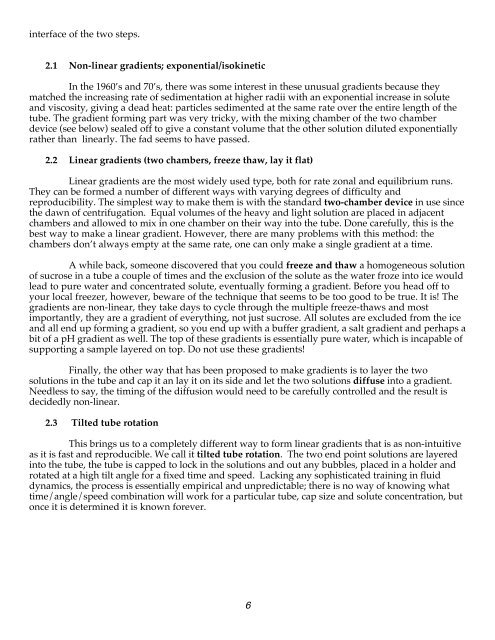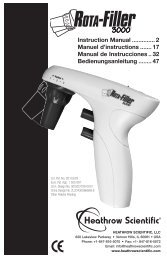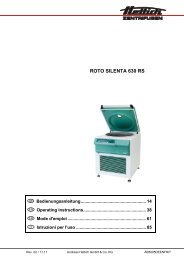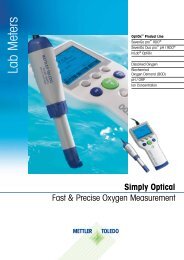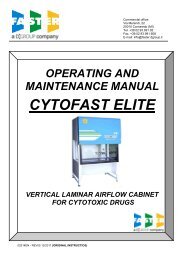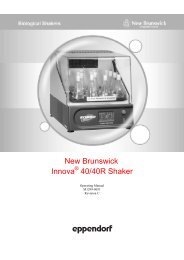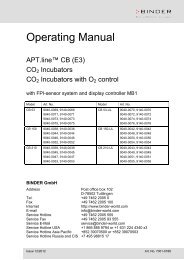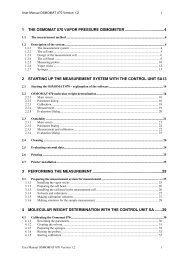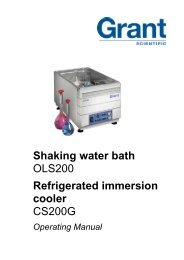Gradient Master - Wolf Laboratories
Gradient Master - Wolf Laboratories
Gradient Master - Wolf Laboratories
You also want an ePaper? Increase the reach of your titles
YUMPU automatically turns print PDFs into web optimized ePapers that Google loves.
interface of the two steps.<br />
2.1 Non-linear gradients; exponential/isokinetic<br />
In the 1960’s and 70’s, there was some interest in these unusual gradients because they<br />
matched the increasing rate of sedimentation at higher radii with an exponential increase in solute<br />
and viscosity, giving a dead heat: particles sedimented at the same rate over the entire length of the<br />
tube. The gradient forming part was very tricky, with the mixing chamber of the two chamber<br />
device (see below) sealed off to give a constant volume that the other solution diluted exponentially<br />
rather than linearly. The fad seems to have passed.<br />
2.2 Linear gradients (two chambers, freeze thaw, lay it flat)<br />
Linear gradients are the most widely used type, both for rate zonal and equilibrium runs.<br />
They can be formed a number of different ways with varying degrees of difficulty and<br />
reproducibility. The simplest way to make them is with the standard two-chamber device in use since<br />
the dawn of centrifugation. Equal volumes of the heavy and light solution are placed in adjacent<br />
chambers and allowed to mix in one chamber on their way into the tube. Done carefully, this is the<br />
best way to make a linear gradient. However, there are many problems with this method: the<br />
chambers don’t always empty at the same rate, one can only make a single gradient at a time.<br />
A while back, someone discovered that you could freeze and thaw a homogeneous solution<br />
of sucrose in a tube a couple of times and the exclusion of the solute as the water froze into ice would<br />
lead to pure water and concentrated solute, eventually forming a gradient. Before you head off to<br />
your local freezer, however, beware of the technique that seems to be too good to be true. It is! The<br />
gradients are non-linear, they take days to cycle through the multiple freeze-thaws and most<br />
importantly, they are a gradient of everything, not just sucrose. All solutes are excluded from the ice<br />
and all end up forming a gradient, so you end up with a buffer gradient, a salt gradient and perhaps a<br />
bit of a pH gradient as well. The top of these gradients is essentially pure water, which is incapable of<br />
supporting a sample layered on top. Do not use these gradients!<br />
Finally, the other way that has been proposed to make gradients is to layer the two<br />
solutions in the tube and cap it an lay it on its side and let the two solutions diffuse into a gradient.<br />
Needless to say, the timing of the diffusion would need to be carefully controlled and the result is<br />
decidedly non-linear.<br />
2.3 Tilted tube rotation<br />
This brings us to a completely different way to form linear gradients that is as non-intuitive<br />
as it is fast and reproducible. We call it tilted tube rotation. The two end point solutions are layered<br />
into the tube, the tube is capped to lock in the solutions and out any bubbles, placed in a holder and<br />
rotated at a high tilt angle for a fixed time and speed. Lacking any sophisticated training in fluid<br />
dynamics, the process is essentially empirical and unpredictable; there is no way of knowing what<br />
time/angle/speed combination will work for a particular tube, cap size and solute concentration, but<br />
once it is determined it is known forever.<br />
6


